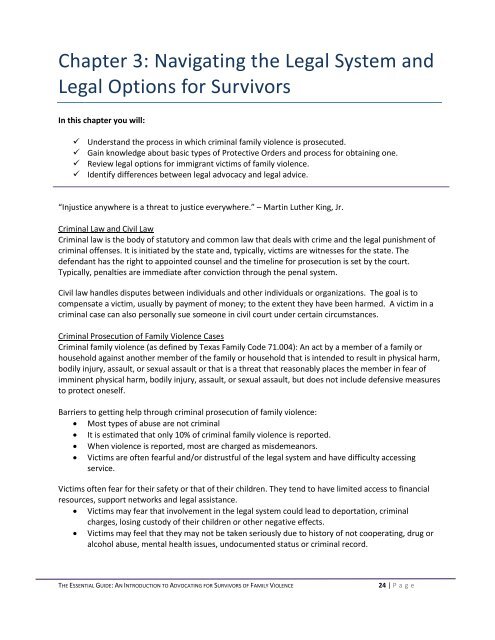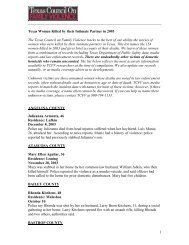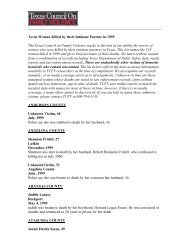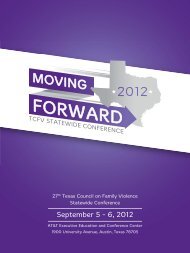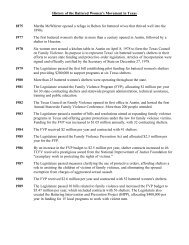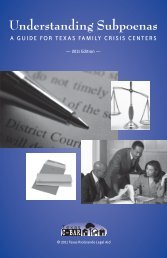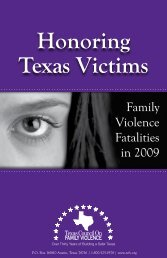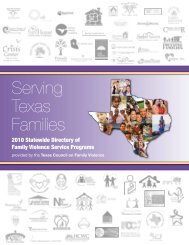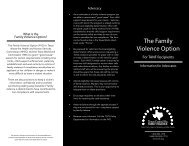the essential guide - Texas Council on Family Violence
the essential guide - Texas Council on Family Violence
the essential guide - Texas Council on Family Violence
Create successful ePaper yourself
Turn your PDF publications into a flip-book with our unique Google optimized e-Paper software.
Chapter 3: Navigating <str<strong>on</strong>g>the</str<strong>on</strong>g> Legal System andLegal Opti<strong>on</strong>s for SurvivorsIn this chapter you will: Understand <str<strong>on</strong>g>the</str<strong>on</strong>g> process in which criminal family violence is prosecuted. Gain knowledge about basic types of Protective Orders and process for obtaining <strong>on</strong>e. Review legal opti<strong>on</strong>s for immigrant victims of family violence. Identify differences between legal advocacy and legal advice.“Injustice anywhere is a threat to justice everywhere.” – Martin Lu<str<strong>on</strong>g>the</str<strong>on</strong>g>r King, Jr.Criminal Law and Civil LawCriminal law is <str<strong>on</strong>g>the</str<strong>on</strong>g> body of statutory and comm<strong>on</strong> law that deals with crime and <str<strong>on</strong>g>the</str<strong>on</strong>g> legal punishment ofcriminal offenses. It is initiated by <str<strong>on</strong>g>the</str<strong>on</strong>g> state and, typically, victims are witnesses for <str<strong>on</strong>g>the</str<strong>on</strong>g> state. Thedefendant has <str<strong>on</strong>g>the</str<strong>on</strong>g> right to appointed counsel and <str<strong>on</strong>g>the</str<strong>on</strong>g> timeline for prosecuti<strong>on</strong> is set by <str<strong>on</strong>g>the</str<strong>on</strong>g> court.Typically, penalties are immediate after c<strong>on</strong>victi<strong>on</strong> through <str<strong>on</strong>g>the</str<strong>on</strong>g> penal system.Civil law handles disputes between individuals and o<str<strong>on</strong>g>the</str<strong>on</strong>g>r individuals or organizati<strong>on</strong>s. The goal is tocompensate a victim, usually by payment of m<strong>on</strong>ey; to <str<strong>on</strong>g>the</str<strong>on</strong>g> extent <str<strong>on</strong>g>the</str<strong>on</strong>g>y have been harmed. A victim in acriminal case can also pers<strong>on</strong>ally sue some<strong>on</strong>e in civil court under certain circumstances.Criminal Prosecuti<strong>on</strong> of <strong>Family</strong> <strong>Violence</strong> CasesCriminal family violence (as defined by <str<strong>on</strong>g>Texas</str<strong>on</strong>g> <strong>Family</strong> Code 71.004): An act by a member of a family orhousehold against ano<str<strong>on</strong>g>the</str<strong>on</strong>g>r member of <str<strong>on</strong>g>the</str<strong>on</strong>g> family or household that is intended to result in physical harm,bodily injury, assault, or sexual assault or that is a threat that reas<strong>on</strong>ably places <str<strong>on</strong>g>the</str<strong>on</strong>g> member in fear ofimminent physical harm, bodily injury, assault, or sexual assault, but does not include defensive measuresto protect <strong>on</strong>eself.Barriers to getting help through criminal prosecuti<strong>on</strong> of family violence: Most types of abuse are not criminal It is estimated that <strong>on</strong>ly 10% of criminal family violence is reported. When violence is reported, most are charged as misdemeanors. Victims are often fearful and/or distrustful of <str<strong>on</strong>g>the</str<strong>on</strong>g> legal system and have difficulty accessingservice.Victims often fear for <str<strong>on</strong>g>the</str<strong>on</strong>g>ir safety or that of <str<strong>on</strong>g>the</str<strong>on</strong>g>ir children. They tend to have limited access to financialresources, support networks and legal assistance. Victims may fear that involvement in <str<strong>on</strong>g>the</str<strong>on</strong>g> legal system could lead to deportati<strong>on</strong>, criminalcharges, losing custody of <str<strong>on</strong>g>the</str<strong>on</strong>g>ir children or o<str<strong>on</strong>g>the</str<strong>on</strong>g>r negative effects. Victims may feel that <str<strong>on</strong>g>the</str<strong>on</strong>g>y may not be taken seriously due to history of not cooperating, drug oralcohol abuse, mental health issues, undocumented status or criminal record.THE ESSENTIAL GUIDE: AN INTRODUCTION TO ADVOCATING FOR SURVIVORS OF FAMILY VIOLENCE24 | P a g e


